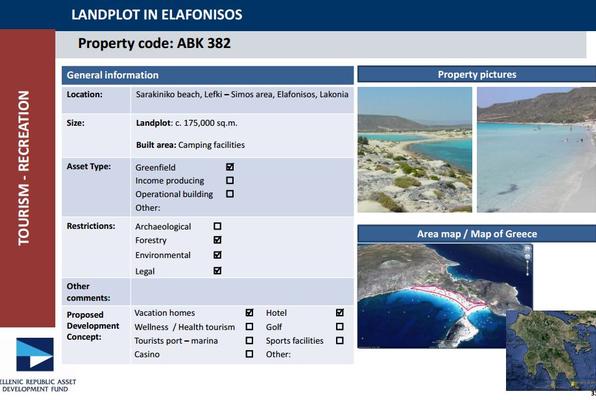Elafonissos is a small island located off Cape Malea of the Peloponnese. The main attraction for nature lovers and tourists in the summer are the white sand beaches of Simos and Sarakinikos (the only two on the island) which stretch around a bend in the coastline and are connected by a thin strip of sand to a tiny, sandy almost-island, forming between them natural turquoise lagoons. The beaches form part of a wider ecosystem of extensive sand dunes which are increasingly rare in the Mediterranean. Once a well-kept secret, they have recently been featured in publications including the Guardian newspaper.
They may grow even rarer now that the area has been transferred to the HRADF with a view to offering a 50-year lease on the property to private investors. The revelation provoked an immediate outcry among outraged citizens and environmental organisations, following news reports of the move to privatise the beaches.
Aside from being an area of obvious, outstanding natural beauty, the area is included in the European NATURA network of protected areas. Coastal sand dunes such as those in Elafonissos are particularly important for biodiversity, being refuges for plants and animals. They are also increasingly being lost due to human activity. Numerous species of birds, small mammals and reptiles breed in the area, and the dunes form habitats for endangered plant species such as the sea daffodil (Pancratium maritimum). Currently the only development in the area is a small camping ground (itself the subject of numerous legal challenges), but which is sited away from the dunes.
The HRADF has now tried to defuse the situation by issuing a press release claiming that there have been no moves to develop the area. However that conclusion is contradicted by the Fund’s own admission that the area has indeed been transferred to its portfolio. According to recent Memorandum laws, all properties transferred to the HRADF must be privatized and cannot be transferred back to the state. So effectively it is only a matter of time before such plans are established.
The Fund went on to state that any future development plans would be particularly gentle and proceed with respect to the natural ecosystems. Once again it is contradicting itself as is clear from the HRADF’s own description of the property (available in English in this pdf, page 31). The Fund’s own ‘Proposed Development Concept’ is for a hotel and vacation homes to be built on the property, and it is clear from the accompanying slides that the buildings would be sited directly on top of the sand dunes.

Therefore even if one takes at face value the Fund’s assertion that any development would occur following proper environmental assessments and public consultation, it is still difficult to see how even with modifications to the initial recommendations (which are portrayed to investors as feasible) any development could go ahead which would not cause irreversible damage to one of the most unique coastal areas in the entire country.